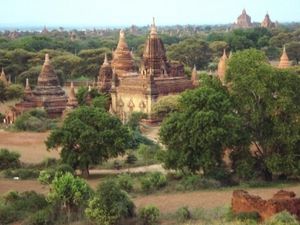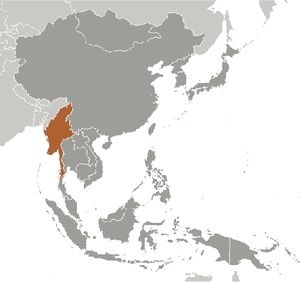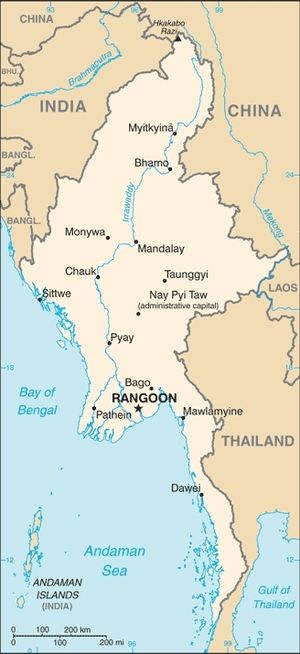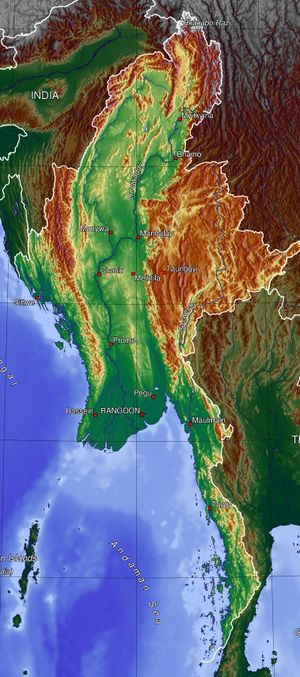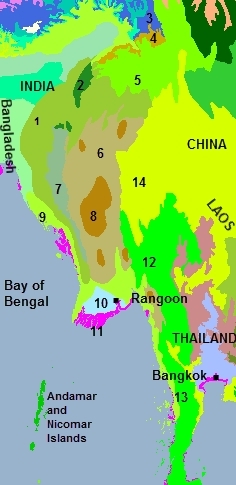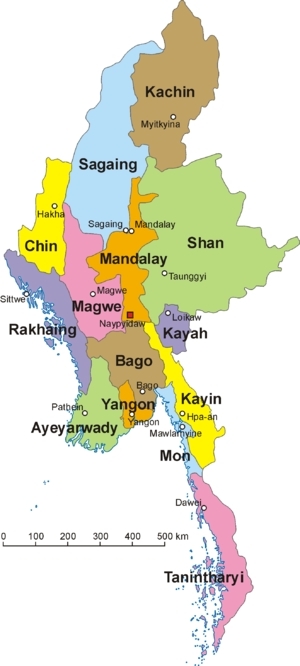Myanmar
Myanmar (also Burma) is a nation of fifty four-and-a-half million people in southeastern Asia, bordering the Andaman Sea and the Bay of Bengal, between Bangladesh and Thailand.
Its major environmental issues include:
- deforestation;
- industrial pollution of air, soil, and water; and,
- inadequate sanitation and water treatment contribute to disease
Myanmar is susceptible to destructive earthquakes and cyclones. Flooding and landslides common during rainy season (June to September). There are also periodic droughts.
Britain conquered Burma over a period of 62 years (1824-1886) and incorporated it into its Indian Empire.
Burma was administered as a province of India until 1937 when it became a separate, self-governing colony; independence from the Commonwealth was attained in 1948.
Gen. Ne Win dominated the government from 1962 to 1988, first as military ruler, then as self-appointed president, and later as political kingpin.
In September 1988, the military deposed Ne Win and established a new ruling junta. Despite multiparty legislative elections in 1990 that resulted in the main opposition party - the National League for Democracy (NLD) - winning a landslide victory, the junta refused to hand over power. NLD leader and Nobel Peace Prize recipient Aung San Suu Kyi, who was under house arrest from 1989 to 1995 and 2000 to 2002, was imprisoned in May 2003 and subsequently transferred to house arrest. She was finally released in November 2010.
After the ruling junta in August 2007 unexpectedly increased fuel prices, tens of thousands of Burmese marched in protest, led by prodemocracy activists and Buddhist monks. In late September 2007, the government brutally suppressed the protests, killing at least 13 people and arresting thousands for participating in the demonstrations. Since then, the regime has continued to raid homes and monasteries and arrest persons suspected of participating in the pro-democracy protests.
Burma in early May 2008 was struck by Cyclone Nargis, which claimed over 138,000 dead and tens of thousands injured and homeless. Despite this tragedy, the junta proceeded with its May constitutional referendum, the first vote in Burma since 1990.
Parliamentary elections held in November 2010, considered flawed by many in the international community, saw the junta's Union Solidarity and Development Party garnering over 75% of the seats. Parliament convened in January 2011 and selected former Prime Minister Thein Sein as president.
Although the vast majority of national-level appointees named by Thein Sein are former or current military officers, the government has initiated a series of political and economic reforms leading to a substantial opening of the long-isolated country. These reforms have included a senior-level dialogue with ASSK, re-registering the NLD as a political party, enabling party members, including ASSK, to contest parliamentary by-elections on 1 April 2012, the release of many (but not all) political prisoners, preliminary peace agreements with some armed ethnic groups, a reduction in media censorship, and an increasingly open debate in the Parliament.
Contents
Geography
Location: Southeastern Asia, bordering the Andaman Sea and the Bay of Bengal, between Bangladesh and Thailand
Geographic Coordinates: 22 00 N, 98 00 E
Area: 676,578 sq km (land: 653,508 sq km; water: 23,070 sq km)
Land Boundaries: 5,876 km (Bangladesh 193 km, China 2,185 km, India 1,463 km, Laos 235 km, Thailand 1,800 km)
Coastline: 1,930 km
Maritime Claims:
territorial sea: 12 nm
contiguous zone: 24 nm
exclusive economic zone: 200 nm
continental shelf: 200 nm or to the edge of the continental margin
Natural Hazards: destructive earthquakes and cyclones; flooding and landslides common during rainy season (June to September); periodic droughts
Terrain: central lowlands ringed by steep, rugged highlands The highest point is Hkakabo Razi (5,881 m).
Climate: tropical monsoon; cloudy, rainy, hot, humid summers (southwest monsoon, June to September); less cloudy, scant rainfall, mild temperatures, lower humidity during winter (northeast monsoon, December to April)
Ecology and Biodiversity
|
1. Mizoram-Manipur-Kachin rain forests 2. Northeast India-Myanmar pine forests 3. Eastern Hilalayan alpine shrub and meadows 4. Northern Triangle temperate forests 5. Northern Triangle subtropical forests 6. Irrawaddy moist deciduous forests 7. Chin Hills-Arakan Yoma montane forests 9. Myanmar coastal rain forests 10. Irrawaddy freshwater swamp forests 12. Kayah-Karen montane rain forests 13. Tenasserim-South Thailand semi-evergreen rain forests 14. Northern Indochina subtropical forests See also: |
People and Society
Population: 54,584,650 (July 2012 est.)
The majority of Burma's people are ethnic Burman. Shan, Karen, Rohingya, Arakanese (Rakhine), Kachin, Chin, and Mon, together with other smaller indigenous ethnic groups, represent about 30% of the population. Indians and Chinese are the largest non-indigenous groups.
Ethnic Groups: Burman 68%, Shan 9%, Karen 7%, Rakhine 4%, Chinese 3%, Indian 2%, Mon 2%, other 5%
Age Structure:
0-14 years: 27.5% (male 7,560,859/female 7,278,652)
15-64 years: 67.5% (male 18,099,707/female 18,342,696)
65 years and over: 5% (male 1,184,291/female 1,533,599) (2011 est.)
Population Growth Rate: 1.07% (2012 est.)
Birthrate: 19.11 births/1,000 population (2012 est.)
Death Rate: 8.1 deaths/1,000 population (July 2012 est.)
Net Migration Rate: -0.3 migrant(s)/1,000 population (2012 est.)
Life Expectancy at Birth: 65.24 years
male: 62.91 years
female: 67.71 years (2012 est.)
Total Fertility Rate: 2.23 children born/woman (2012 est.)
Languages: Burmese (official). Note: minority ethnic groups have their own languages.
Burmese is the most widely spoken language (approx. 32 million native speakers). Ethnic groups have retained their own identities and languages. Some of the most prominent are Shan; various Karen, Karenni and Chin languages; Arakanese; Kachin; Mon; Palaung; Parauk; Wa; and Yangbye. English is spoken in many areas frequented by tourists. Indian and Chinese residents speak various languages and dialects of their homelands: Hindi, Urdu, Tamil, Bengali, Mandarin, Fujian, and Cantonese.
Literacy (age 15 and over can read and write): 89.9% (2006 est.)
Urbanization: 34% of total population (2010) growing at an annual rate of change of 2.9% (2010-15 est.)
An estimated 89% of the population practices Buddhism. Other religions--Christian 4% (Baptist 3%, Roman Catholic 1%), Muslim 4%, and animist 1%--are less prevalent, although Christian and Muslim groups claim the government significantly underestimates their number of adherents.
According to Burmese Government budget data, public health expenditure has accounted for less than 1% of total government spending. High infant mortality rates and short life expectancies further highlight poor health and living conditions. Tuberculosis, diarrheal disease, malaria, and HIV/AIDS pose serious threats to the Burmese population. The Global Fund to Fight AIDS, Tuberculosis and Malaria re-entered Burma in early 2011. In 2009, the UNDP's Human Development Index, which measures achievements in terms of life expectancy, educational attainment, and adjusted real income, ranked Burma 138 out of 182 countries.
Burmese authorities have perpetrated numerous documented human rights violations, including extrajudicial killings, disappearances, rape, torture, and incommunicado detentions. Internal displacement and refugee outflows of ethnic minorities are prevalent. Over two million Burmese, many of them ethnic minorities, have fled for economic and political reasons to Thailand, Bangladesh, India, China, Indonesia, Malaysia, and elsewhere.
In Burma, there are approximately 750,000 stateless Rohingya in Northern Rakhine State. Elsewhere, there are roughly 150,000 Burmese living in nine refugee camps in Thailand along the border with Burma. Approximately 28,000 Burmese Rohingya are registered as living in two official refugee camps in Bangladesh, and more than 200,000 unregistered Rohingya live in surrounding towns and villages outside of the two camps.
Malaysia hosts more than 90,000 refugees and asylum seekers, primarily in urban areas, 91% of whom are from Burma. Chin and Rohingya comprise the largest groups of this population. Up to 100,000 unregistered Burmese Chin are living in India's Mizoram State, with another 7,500 Burmese refugees and asylum seekers (primarily Chin) in Delhi, India, of which up to 4,000 are UN High Commissioner for Refugees (UNHCR)-registered refugees.
History
Burma was unified by Burman dynasties three times during the past millennium. The first such unification came with the rise of the Bagan (Pagan) Dynasty in 1044 AD, which is considered the "Golden Age" in Burmese history. During this period, Theravada Buddhism first made its appearance in Burma, and the Bagan kings built a massive city with thousands of pagodas and monasteries along the Irrawaddy River. The Bagan Dynasty lasted until 1287 when Mongol invaders destroyed the city. Ethnic Shan rulers, who established a political center at Ava (near Mandalay), filled the ensuing political vacuum for a short time.
In the 15th century, the Taungoo Dynasty succeeded again in unifying under Burman rule a large, multi-ethnic kingdom. This dynasty, which lasted from 1486 until 1752, left little cultural legacy, but expanded the kingdom through conquest of the Shans. Internal power struggles and the cost of protracted warfare led to the eventual decline of the Taungoo Dynasty.
The final Burman royal dynasty, the Konbaung, was established in 1752 under the rule of King Alaungpaya and lasted until the fall of King Thibaw to Britain in 1885. Like the Taungoo Kings, the Konbaung rulers focused on warfare and conquest. Wars were fought with the ethnic Mons and Arakanese, and with the Siamese. The Burmese sacked the Siamese capital of Ayuthaya in 1767. This period also saw four invasions by the Chinese and three devastating wars with the British.
The British began their conquest of Burma in 1824, expanding their holdings after each of the three wars. At the end of the third war in 1885, the British gained complete control of Burma, annexing it to British India.
A group of Burmese nationalists known as the “30 Comrades,” led by General Aung San, joined the Japanese forces in driving out the British at the outbreak of World War II. However, the Burmese Army switched sides in mid-1945 and aided U.S. and British forces in their drive to Rangoon against the Japanese. After the war, the Burmese, with General Aung San at the helm, demanded complete political and economic independence from Britain. The British Government acceded to these demands. A constitution was completed in 1947 and independence granted in January 1948. General Aung San was assassinated with most of his cabinet before the constitution went into effect.
During the constitutional period from 1948 to 1962, Burma had a democratic, parliamentary government. However, the country suffered widespread conflict and internal struggle. Constitutional disputes and persistent division among political and ethnic groups contributed to the democratic government's weak hold on power. In 1958, Prime Minister U Nu accepted military rule temporarily to restore political order. The military stepped down after 18 months.
In 1962 General Ne Win led a military coup, abolishing the constitution and establishing a xenophobic military government. Under his “Burmese Way to Socialism,” he established socialist economic policies that had devastating effects on the country's economy and business climate. In 1974 Ne Win established the Burma Socialist Program Party (BSPP), the sole political party allowed in the country.
On November 25, 1974, former UN Secretary General U Thant died in New York. His body was flown back to Rangoon, where Ne Win had ordered that he be buried without any official honors. On the day of his funeral, December 5, tens of thousands of Burmese came out to pay their respects. Student demonstrators took U Thant’s coffin and paraded through the streets before the demonstrators buried him on the site of the former Rangoon University Students Union. Demonstrations and anti-government speeches continued until December 11, when government troops stormed the campus, killing several students and taking away U Thant’s coffin to bury it near the Shwedagon Pagoda. Riots broke out in Rangoon and the government declared martial law in order to crush the student demonstrations. Student protests that broke out in subsequent years were also similarly suppressed.
In March 1988, student-led demonstrations broke out in Rangoon in response to the worsening economic situation and evolved into a call for regime change. Despite repeated violent crackdowns by the military and police, the demonstrations increased in size and many in the general public joined the students. During mass demonstrations on August 8, 1988, military forces killed more than 1,000 demonstrators. At a rally following this massacre, Aung San Suu Kyi, the daughter of General Aung San, made her first political speech and assumed the role of opposition leader.
In September 1988, a group of generals deposed Ne Win's Burmese Socialist Program Party, suspended the constitution, and established a new ruling junta called the State Law and Order Restoration Council (SLORC). In an effort to "restore order," the SLORC sent the army into the streets to suppress the ongoing public demonstrations. An estimated additional 3,000 were killed, and more than 10,000 students fled into the hills and border areas. Many left the country.
The SLORC ruled by martial law until national parliamentary elections were held in May 1990. These elections were judged generally to be free and fair. The military made little effort to intimidate voters, erroneously assuming their preferred candidates would win. The results were an overwhelming victory for Aung San Suu Kyi's National League for Democracy party, which won nearly 60% of the vote and 392 of the 485 seats, even though she was under house arrest at the time of the elections. The SLORC refused to honor the results or call the parliament into session, instead imprisoning many political activists and maintaining its grip on power.
The ruling junta changed its name to the State Peace and Development Council (SPDC) in 1997, but did not change its policy of autocratic control and repression of the democratic opposition. It continued to subject Aung San Suu Kyi to varying forms of detention and other restrictions on her movement, which it periodically lifted only to reinstate later. In May 2002, Aung San Suu Kyi was allowed to leave her home, and she subsequently traveled widely throughout the country, where she was greeted by large crowds. On May 30, 2003, Aung San Suu Kyi and a convoy of her supporters were attacked by a group of regime-affiliated thugs. Many members of the convoy were killed or injured, and others disappeared. Aung San Suu Kyi and other members of her party were detained.
In October 2004, hard-line members of the senior leadership consolidated their power by ousting Prime Minister General Khin Nyunt and removing him and his allies from control of the government and military intelligence apparatus. Following a sharp increase in fuel prices on August 15, 2007, pro-democracy groups began a series of peaceful marches and demonstrations to protest the deteriorating economic situation in Burma. The regime responded by arbitrarily detaining over 150 pro-democracy activists in August and September 2007, including Min Ko Naing and Ko Ko Gyi, both previously-imprisoned key figures in the 1988 demonstrations. On August 28, 2007, as popular dissatisfaction spread, Buddhist monks began leading peaceful marches. On September 5, 2007, security forces in the town of Pakkoku violently broke up demonstrations by monks, resulting in injuries and triggering calls for a nationwide response and a government apology for the incident.
Beginning on September 18, 2007, monks resumed their peaceful protests in several cities throughout the country. These marches grew quickly to include ordinary citizens, culminating in a large gathering of protestors in Rangoon on September 24. On September 26 and 27, the regime renewed its violent crackdown, shooting, beating, and arbitrarily detaining thousands of monks, pro-democracy activists, and onlookers. The regime confirmed the deaths of only 10 protestors. However, some non-governmental organizations (NGOs) estimated the number of casualties to be much higher, and in his December 7, 2007, report to the UN General Assembly, Special Rapporteur on the Situation of Human Rights in Myanmar Paulo Sergio Pinheiro stated that there were over 30 fatalities in Rangoon associated with the September 2007 protests. In retribution for leading protest marches, monks were beaten and arrested, many monks were disrobed, and several monasteries were raided, ransacked, and closed. In addition to the more than 1,100 political prisoners whose arrests predate the crackdown, another thousand or more were detained due to their participation in the September 2007 protests.
Following the regime's 1993 proclamation of a seven-step roadmap to democracy and a subsequent national convention which convened intermittently, the regime in September 2007 concluded the process of "drafting" principles for the new constitution. Delegates to the convention were not allowed to debate freely, discuss, or attempt to amend the principles. In October 2007, the SPDC appointed 54 pro-regime persons to sit on a constitution drafting committee. The government declared the completion of the constitution drafting committee's work in February 2008, and announced that it would hold a national referendum on the constitution in May 2008, with multi-party elections planned for 2010. While the referendum law provided for a secret ballot, free debate was not permitted and activities considered "interfering with the referendum" carried a 3-year prison sentence. The government carried out the referendum in May 2008 amidst the aftermath of the humanitarian disaster caused by Cyclone Nargis. Although the referendum was rife with irregularities, the government announced that 92.48% of voters approved the constitution, with a 98% voter turnout. Independent observers do not consider those figures to be credible.
Cyclone Nargis hit Irrawaddy and Rangoon Divisions May 2-3, 2008. The storm devastated a huge swath of the Irrawaddy Delta region, wiping out entire villages, leaving an estimated 138,000 Burmese dead or missing, and affecting approximately 2.4 million people, according to the UN Office for the Coordination of Humanitarian Affairs (OCHA). Burmese authorities were criticized for their initial reluctance to grant access to the affected region by international donors, though such access was granted in the ensuing months.
Starting in November 2008, the government imposed harsh sentences on large numbers of political prisoners it had arrested over the course of the previous year, including Min Ko Naing and Ko Ko Gyi. The trials were closed and did not appear to meet minimum standards of due process. The imprisoned activists were convicted, mainly in closed-door hearings, of unlawful association, illegally distributing print and video media, or generally destabilizing public security and the security of the state and were given lengthy sentences, some as long as 68 years.
On May 14, 2009, security forces took Aung San Suu Kyi from house arrest to Insein prison and charged her and her two assistants with baseless crimes related to an uninvited U.S. citizen who swam to her home. Following a trial that was widely viewed as unfair, on August 11, 2009, Aung San Suu Kyi and her two assistants were convicted of violating the terms of her house arrest. The international community criticized her conviction and subsequent sentence to an additional 18 months of house arrest. The SPDC government released Aung San Suu Kyi on November 13, 2010, after more than 7 years' continuous detention. However, the government continues to hold an estimated 2,100 other political prisoners.
In March 2010, the government published widely criticized election and party registration laws to govern the conduct of elections planned for 2010. The laws annulled the results of the 1990 elections, barred political prisoners from party membership and parliamentary candidacy, and granted broad authority to the regime-appointed Union Election Commission to oversee and regulate political party activities. In April 2010, all active-duty cabinet ministers resigned their military commissions, reportedly to prepare for candidacy in the 2010 elections. Prime Minister Thein Sein was appointed head of the pro-government Union Solidarity and Development Party.
The country held its first elections in 20 years on November 7, 2010. The United States condemned the planning and the execution of the elections as neither free nor fair. The regime proxy Union Solidarity and Development Party won over three-quarters of elective parliamentary seats, although observers around the country reported widespread electoral malfeasance, including abuse of advance voting procedures. Per Burma's 2008 constitution, military appointees fill one-quarter of all parliamentary seats. The new, nominally civilian government took office on April 1, 2011, and the SPDC was dissolved. Insiders from the SPDC era fill almost all key positions at the national level and most at the state/region level. The current roles of the former top two SPDC leaders, Senior General Than Shwe and Vice Senior General Maung Aye, remain unclear.
In November 2005, the ruling regime unexpectedly relocated the capital city from Rangoon to Nay Pyi Taw, located in central Burma approximately 200 miles north of Rangoon, further isolating the government from the public and international community. Most government workers and ministries moved to Nay Pyi Taw over the following 6 months, and rapid development of the new capital continues. Foreign diplomatic missions are still located in Rangoon and no country has yet announced plans to move its embassy to Nay Pyi Taw.
The government has a contentious relationship with Burma's ethnic groups, many of which fought for greater autonomy or secession for their regions after the country's independence in 1948. At the time of independence, only Rangoon itself was under the control of national government authorities. Subsequent military campaigns brought more and more of the nation under central government control. Since 1989, the regime has entered into a series of ceasefire agreements with insurgent groups, though a few armed groups remain in active opposition. In 2009, the regime began pressuring ceasefire groups to join a Border Guard Force (BGF)--an integrated unit of Burma Army and ceasefire group soldiers, with Burma Army soldiers occupying the key positions; no major ceasefire group has agreed to these demands. In June 2009 the Burma Army and its affiliate, the Democratic Karen Buddhist Army, launched an attack against the Karen National Union. In August 2009 the Burma Army defeated the Myanmar National Democratic Alliance Army, an ethnic Kokang group, in an offensive in which thousands of people fled to China and the Burma Army destroyed a weapons and narcotics processing facility in the Kokang region. In the wake of the November 2010 elections, the Burma Army launched a series of attacks against armed ethnic groups in Karen and Shan States. In June 2011, fighting broke out between the Burmese Army and the Kachin Independence Army in northern Burma’s Kachin State with clashes continuing as of August 2011.
Government
Government Type: Type: Nominally civilian regime comprised primarily of former senior military officers.
Constitution: Burma adopted a new constitution through a deeply flawed May 2008 national referendum. The government held elections in November 2010, though credible observers inside and outside Burma found numerous flaws with the process leading to the elections and election-day conduct (including government-sponsored malfeasance). The constitution went into effect with the seating of a new Parliament in early 2011.
Burma remains an authoritarian country dominated by active or former members of the military. The nation is headed by a civilian president and two vice presidents. On paper, power is apportioned between executive, legislative, and judicial branches. The military remains an institution unto itself, and the head of the armed forces retains the right to invoke extraordinary powers including the ability to suspend civil liberties and abrogate parliamentary authority.
The SPDC changed the name of the country to "Myanmar" in 1989, but some members of the democratic opposition and other political activists do not recognize the name change and continue to use the name "Burma." Out of support for the democratic opposition, and its victory in the 1990 election, the U.S. Government likewise uses "Burma."
|
Capital: Rangoon - 4.259 million (2009) Other Major Cities: Mandalay 1.009 million; Nay Pyi Taw 992,000 (2009) Administrative divisions: Burma consists of 14 states and regions. Administrative control is exercised by the central government through a system of subordinate executive bodies headed by chief ministers. It is unclear how the country's new civilian regional power structures will share responsibilities with regional military commanders. 7 divisions (taing-myar, singular - taing) and 7 states* (pyi ne-myar, singular - pyi ne) divisions:
states:
|
Independence Date: 4 January 1948 (from the UK)
Legal System: Myanmar accepts compulsory International Court of Justice (ICJ) jurisdiction; and accepts International criminal court (ICCt) jurisdiction
International Environmental Agreements
Myanmar is party to international agreements on: Biodiversity, Climate Change, Climate Change-Kyoto Protocol, Desertification, Endangered Species, Law of the Sea, Ozone Layer Protection, Ship Pollution, Tropical Timber 83, and Tropical Timber 94.
Water
Total Renewable Water Resources: 1,045.6 cu km (1999)
Freshwater Withdrawal: 33.23 cu km/yr (1% domestic, 1% industrial, 98% agricultural)
Per Capita Freshwater Withdrawal: 658 cu m/yr (2000)
Access to Improved Drinking Water Sources: 71% of population
Access to Improved Drinking Sanitation Facilities: 81% of population
Agriculture
Agricultural products: rice, pulses, beans, sesame, groundnuts, sugarcane; hardwood; fish and fish products
Irrigated Land: 22,500 sq km (2008)
Resources
Natural Resources: petroleum, timber, tin, antimony, zinc, copper, tungsten, lead, coal, marble, limestone, precious stones, natural gas, hydropower
Land Use:
Economy
Burma is a resource-rich country with a strong agricultural base. It has vast hardwood timber, natural gas, and fishery reserves and is a leading source of gems and jade. Tourist potential remains underdeveloped because of weak infrastructure and Burma's international image, which has been damaged by the regime's human rights abuses and political oppression. Due to Burma's poor human rights record, the United States imposes an array of economic and travel sanctions, including bans on the importation of Burmese products into the U.S. and the export of financial services from the United States to Burma. Australia, Canada, and the EU also impose economic sanctions on the Burmese regime. Information on U.S. sanctions is available at http://www.treasury.gov/resource-center/sanctions/Programs/pages/burma.aspx.
Despite Burma's growing GDP, the regime's mismanagement of the economy has created a downward economic spiral for the people of Burma. The state remains heavily and inefficiently involved in most parts of the economy, infrastructure has deteriorated, and rule of law does not exist. The majority of Burmese citizens lead a subsistence-level existence with minimal opportunity for economic improvement. Inflation, though relatively low in 2009, increased in 2010 and shows signs of remaining higher in 2011.
The military's commercial entities play a major role in the economy. The limited moves to a market economy, begun in 1990, have been accompanied by a significant rise in crony capitalism. A handful of individuals loyal to the regime benefit from policies that promote monopoly and privilege. State-controlled activity predominates in energy, heavy industry, and the rice trade. The state embarked on a campaign to privatize state-owned enterprises and properties in late 2009 and continued to sell off assets throughout 2010 and into 2011. By all credible accounts most buyers of these privatized assets have been those closely connected to the regime: crony businessmen, the military's for-profit business arms, and proxies acting on behalf of military families.
Burma remains a primarily agricultural economy with 50% of GDP derived from agriculture, livestock and fisheries, and forestry. Burma's rice exports hit a near-record high in 2009, but experienced a more than 50% drop in 2010 due to drought, delayed monsoon rains, and a government desire to carefully control domestic rice prices. Manufacturing/industry constitutes only 15% of recorded economic activity, and state industries continue to play a large role in that sector. Trade and services constitute 35% of GDP.
A wave of foreign investors pulled out of Burma beginning in 1997 due to the increasingly unfriendly business environment and political pressure, some in the form of sanctions, from Western governments, consumers, and shareholders. However, successive waves of new investment from regional neighbors, predominately China, has increased in recent years and is very difficult to quantify accurately. The government conserves foreign exchange by limiting imports and promoting exports. Published estimates of Burma's foreign trade (particularly regarding imports) are greatly understated because of the large volume of off-book, black-market, illicit, and unrecorded border trade. In the near term, growth will continue to be constrained by government mismanagement and minimal investment. Government economic statistics are often unavailable and unreliable. According to official figures, GDP growth has been over 10% annually since FY 1999-2000. However, the true rate is likely lower; the Economist Intelligence Unit estimated that the growth rate in 2010 was 3.1% and predicted 3.2% growth in 2011. Burma's economic growth has been driven by its natural gas exports, which account for over half of Burma's export receipts and foreign direct investment. Natural gas exports will increase significantly once production begins from the offshore Shwe and Shwephyu Fields, estimated to hold 5.7-10 trillion cubic feet of natural gas. Much of the gas from these fields will flow to China's Yunnan Province via a pipeline currently under construction by a consortium of Burmese and foreign partners, with an estimated completion date of 2014. A second roughly parallel pipeline will carry Middle East- and Africa-origin crude oil offloaded by tankers at a port in Rakhine State. Corporations based in China, India, South Korea, Thailand, Russia, Australia, France, and Malaysia have interests in the exploration and development of several offshore and onshore blocks. One U.S. corporation continues to maintain its interests in the energy sector, with an investment that predates U.S. sanctions.
Burma remains the world's second-largest producer of illicit opium--amounting to 5% of the world's total, according to a 2009 UN Office on Drugs and Crime (UNODC) report. Annual production of opium has been estimated at less than 15% of mid-1990 peak levels. Cultivation rose for 3 years following a steady decline through 2006, but yields fell during that period. Burma is a major source of amphetamine-type stimulants in Asia. Although the Burmese Government has expanded its counternarcotics measures in recent years, production and trafficking of narcotics remain major issues. The Burmese Government has actively pursued mid-level and independent traffickers, but it remains reluctant to investigate, arrest, and prosecute high-level international traffickers associated with ethnic ceasefire groups.
Despite Burma's emergence as a natural gas exporter, socio-economic conditions have deteriorated under the regime's mismanagement, leaving most of the public in poverty, while military leaders and their business cronies exploit the country's ample natural resources. The transfer of state assets, especially real estate, to cronies and military families in 2010 under the guise of a privatization policy further widened the gap between the economic elite and the public.
The economy suffers from serious macroeconomic imbalances - including unpredictable inflation, fiscal deficits, multiple official exchange rates that overvalue the Burmese kyat, a distorted interest rate regime, unreliable statistics, and an inability to reconcile national accounts.
Burma's poor investment climate hampers the inflow of foreign investment; in recent years, foreign investors have shied away from nearly every sector except for natural gas, power generation, timber, and mining.
The exploitation of natural resources does not benefit the population at large. The business climate is widely perceived as opaque, corrupt, and highly inefficient.
Over 60% of the FY 2009-10 budget was allocated to state owned enterprises - most operating at a deficit. The most productive sectors will continue to be in extractive industries - especially oil and gas, mining, and timber - with the latter two causing significant environmental degradation. Other areas, such as manufacturing, tourism and services, struggle in the face of inadequate infrastructure, unpredictable trade policies, neglected health and education systems, and endemic corruption.
A major banking crisis in 2003 caused 20 private banks to close; private banks still operate under tight restrictions, limiting the private sector's access to credit.
The United States, the European Union, and Canada have imposed financial and economic sanctions on Burma. US sanctions, prohibiting most financial transactions with Burmese entities, impose travel bans on senior Burmese military and civilian leaders and others connected to the ruling regime, and ban imports of Burmese products. These sanctions affected the country's fledgling garment industry, isolated the struggling banking sector, and raised the costs of doing business with Burmese companies, particularly firms tied to Burmese regime leaders.
The global crisis of 2008-09 caused exports and domestic consumer demand to drop. Remittances from overseas Burmese workers - who had provided significant financial support for their families - slowed or dried up as jobs were lost and migrant workers returned home. Although the Burmese government has good economic relations with its neighbors, significant improvements in economic governance, the business climate, and the political situation are needed to promote serious foreign investment.
GDP: (Purchasing Power Parity): $82.72 billion (2011 est.)
GDP: (Official Exchange Rate): $50.2 billion (2011 est.)
GDP- per capita (PPP): $1,300 (2011 est.)
GDP- composition by sector:
agriculture: 43%
industry: 20.5%
services: 36.6% (2011 est.)
Industries: agricultural processing; wood and wood products; copper, tin, tungsten, iron; cement, construction materials; pharmaceuticals; fertilizer; oil and natural gas; garments, jade and gems
Currency: Kyats (MMK)
